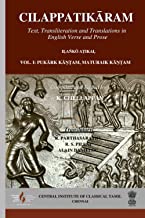|
 Cilappatik?ram, the epic of the anklet is the first known epic of the Tamils, and the first of the five great epics is the quintessential work of the Tamil mind and culture representing the final phase of the classical age in Tamil poetry. Whereas Tolk?ppiyam does not mention K?ppiyam, Ta??iyala?k?ram is based on the Sanskrit Kavya tradition and even though T.P. Meenakshisundaran has called it the epic of the common man, he also tries to relate Cilappatik?ram to the theory of Ta??iyala?k?ram particularly the four Purushartas of the K?vya tradition. We can see the marvel of the story of the common people becoming an epic only in Tamil. Eminent Jains and others have said that human beings can attain divinity through their own effort. Cilappatik?ram only shows the possibility of even a woman evolving into such a sublime height as to make the entire world worship her. Whereas the Sanskrit epics speak of the descent of gods, Cilappatik?ram speaks of the ascent of humanity and that too, a woman belonging to a merchant family. In another sense, Cilappatik?ram is the Tamil counterpart to the Sanskrit tradition as it is based on an extension of the Akam-Puram tradition and the three cantos focus on the three cities of the Three Kingdoms of Tamilnadu. Here the old five geographical divisions become three political units. But they are absorbed in these divisions-we have Marutam (field) and Neytal (seaside) in Puk?r, Mullai (forest), and P?lai (desert) in Maturai and Kuriñci hills inVañci. The epic has a new vision of united Tamilnadu and Ka??aki becomes the symbol of this new consciousness as she is worshipped by all. C?ran Ce?ku??uvan who goes to North on behalf of all the Tamil Kings is the masculine/political counterpart to the values symbolized by Ka??aki who is the feminine domestic counterpart to the heroism of the king. Hence, we may call Cilappatik?ram, the epic of Tamil consciousness and culture combining the Akam and Puram ti?ais. The anklet is a symbol of femininity and domestic harmony. When K?valan takes it to be sold in Maturai streets, he converts a symbol of chastity into an object of exchange. The dominance of economic values over human values in society is also shown here. Earlier when K?valan "buys" M?tavi by buying the garland also see the same process. The separation of the two anklets can also be seen as symbolic of the division or disruption in domestic life. When Ka??aki breaks the other anklet to prove that K?valan is not guilty, the jewel leaps and silences the king. This leaping of the anklet can be seen as a symbol of the humble female evolving into a heroic figure. Now the anklet signifies the power of feminine love as well as justice. At the plot level, the anklet brings out the complication as well as the denouement and restores a kind of order. It is the pivot around which the plot revolves. It serves as the site of the context of the meanings or motifs of the epic. It connects the three motifs of the epic mentioned in the patikam. It shows that Aram/Dharma will be death to those who deviate from the political code. It shows the power of chastity which is praised by eminent men. It also shows that inexorable fate asserts itself in ripe moments, as it happens when K?valan is killed by the orders of the king when the goldsmith claims that K?valan had stolen the Queen?s anklet. But it is the other anklet that helps to unravel the knot. If Cilappatik?rammainly deals with a woman?s tragedy caused by fate it also shows the triumph of humanist and matriarchal values and cilampu is a symbol of both. The epic was composed by I?a?k? A?ika?, who is said to be the younger brother of C?ran Ce?ku??uvan who appears in the epic and honours Ka??aki who was deified in his country by erecting a temple with the stones brought from the North. |

